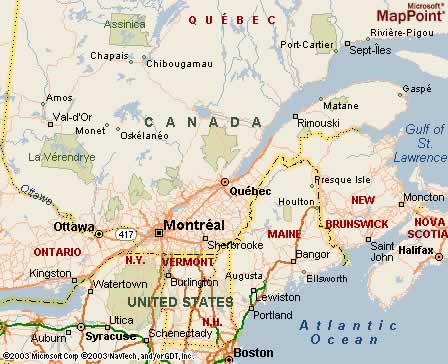|
|
Canku Ota |
|
||||||||||
|
(Many Paths) |
||||||||||||
|
An Online Newsletter Celebrating Native America |
||||||||||||
|
February 21, 2004 - Issue 107 |
||||||||||||
|
|
||||||||||||
|
Elders provide
snapshots of Inuit culture |
||||||||||||
|
by Jane George -Nunatsiaq
News
|
||||||||||||
|
credits:
|
|
The exhibit is the fruit of Breton's three-month stay last summer in Inukjuak. She is studying toward a masters' degree in anthropology under Louis-Jacques Dorais at Université Laval, and went to Inukjuak on a research project of her own design. Her goal was to see what photos elders and youth would take about what's important to them in Inuit culture and what's worth preserving. "I
gave 10 disposable cameras to elders and 10 to youth and asked them
what they didn't want to see disappear in their environment. I wanted
to give them just a month, but they all wanted more because they
brought the cameras to their summer camps," Breton says. "One
asked for a second camera!" "The elders were really enthusiastic, they said, 'Finally, I've been wishing I could take photos of my camp, it's been so long. I will able to show these to my grandchildren,'" Breton says. "They were really happy." The elders' photos showed mainly traditional activities, young people learning traditional skills and aspects of nature. "I developed these shots, and then I went back with the translator to learn more about them," Breton says. Breton's
project was helped out by strategic support from Université
Laval and Nunavik's Avataq Cultural Institute. The camera company,
Konica-Minolta, supplied the disposable cameras for participants
and a lens for her camera. Air Inuit underwrote 90 per cent of Breton's
ticket to the community, but that was all the financial help she
received. "I had to use my own money to pay my translator [Eva Weetaluktuk] and the participants. So, I worked unloading the sealift cargo for the co-op during one entire night alongside many local residents and my translator and I were hired a few hours a day for a month as housekeepers for construction crews.... In spite of this, my credit card was maxed out, but I didn't have any alternative if I wanted to pursue my project," Breton says.
Breton had studied film and already had a book of photographs and two awards to her credit before embarking on the Inukjuak project. "When I was developing the photos [of Inukjuak] in black and white in the back of a closet, I was really excited to discover a new land and an Inuit vision in each and every one," Breton says. "I was touched to see that the elders had participated so seriously in this project and taken their cameras with them in the camps to show me the details." As
many of the participants in the project were out camping for most
of the summer, and Breton had to leave Inukjuak in August, she wasn't
able to complete all her interviews with the photographers. And
she only got back three of the 10 cameras that she had handed out
to the youth participants. "Visual anthropology is, in my opinion, even more worth exploring and developing because in the context we live in, even in the North, we're bombarded by images, broadcast or printed, that come from every corner of our planet," Breton says. Breton says it's too early to draw many conclusions from what the photos say, but, in her opinion, there seem to be more connections between the generations' view of their world than might have been expected. "The youth took only a couple of photos of the town, even though their photos of the land seemed to show that they go there more for leisure than to gather food," Breton says. Until
she's reached a larger sample of youth in Inukjuak, her project,
and the masters' thesis she intends to write, won't be finished. Breton plans to mount the photos in blocks of ice. Colour photos by elders Adamie Niviaxie, Leah Niviaxie, Mary Patsauq Iqaluk, Samisa Kingalik and Tyna Amidlak are included in the exhibition, as well as her own black and white photos. The exhibition's opening takes place on Feb. 16 from 4 to 6 p.m. Breton hopes some Nunavimmiut will attend. When she returns to Inukjuak next summer, Breton says she will be bringing the photos along. She would also like to bring a photography exhibit to Nunavik during the winter when photos could be again exhibited in a traditional igloo. |
|
|
www.expedia.com |
|
|
||
|
|
||
| Canku Ota is a free Newsletter celebrating Native America, its traditions and accomplishments . We do not provide subscriber or visitor names to anyone. Some articles presented in Canku Ota may contain copyright material. We have received appropriate permissions for republishing any articles. Material appearing here is distributed without profit or monetary gain to those who have expressed an interest. This is in accordance with Title 17 U.S.C. Section 107. | ||
|
Canku Ota is a copyright © 2000, 2001, 2002, 2003, 2004 of Vicki Lockard and Paul Barry. |
||
 |
 |
|
|
The "Canku Ota - A Newsletter Celebrating Native America" web site and its design is the |
||
|
Copyright © 1999, 2000, 2001, 2002, 2003, 2004 of Paul C. Barry. |
||
|
All Rights Reserved. |
||
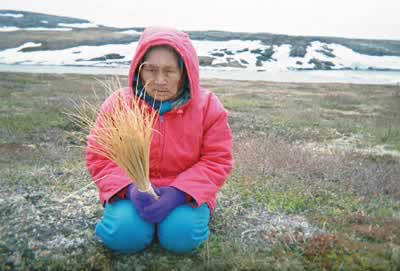 A
loving look at Inuit culture and traditions is the focus of Visions
Inuit, an exhibit that opens next week in Quebec City and features
photos by six Inukjuak elders and photographer Amélie Breton.
A
loving look at Inuit culture and traditions is the focus of Visions
Inuit, an exhibit that opens next week in Quebec City and features
photos by six Inukjuak elders and photographer Amélie Breton.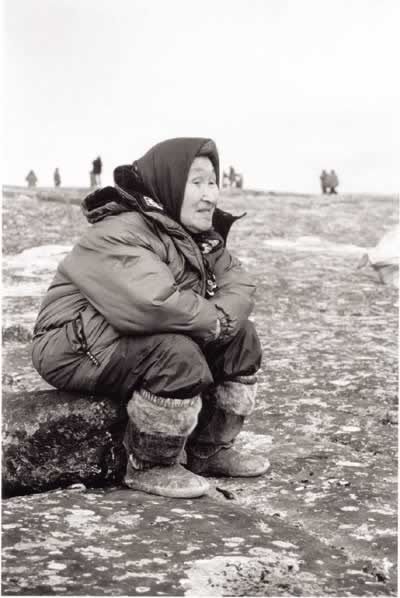 Breton's
idea was to compare the visions of the two generations- the over-55
and those age 16 to 20 - and see whether the photos could offer
clues about how Inuit of different ages look at the world and their
identity as Inuit.
Breton's
idea was to compare the visions of the two generations- the over-55
and those age 16 to 20 - and see whether the photos could offer
clues about how Inuit of different ages look at the world and their
identity as Inuit.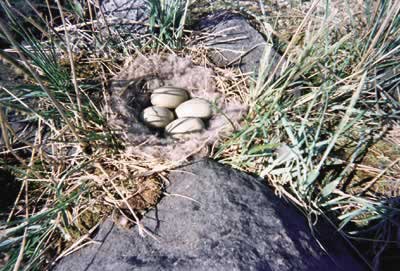 Breton
first visited Inukjuak in 2002 on a contract for the health and
social services commission of the First Nations of Quebec and Labrador,
La Commission de la Santé et des Services Sociaux des Premières
Nations du Québec et du Labrador.
Breton
first visited Inukjuak in 2002 on a contract for the health and
social services commission of the First Nations of Quebec and Labrador,
La Commission de la Santé et des Services Sociaux des Premières
Nations du Québec et du Labrador.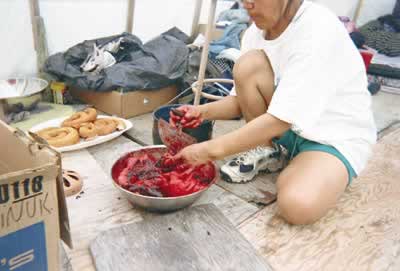 Breton
plans to return to Inukjuak next summer to finish her interviews
and recruit more young people who would be keen on taking photos.
She looks at this project as the beginning of a career in visual
anthropology - that is, the study of people through visual means,
such as photos or film.
Breton
plans to return to Inukjuak next summer to finish her interviews
and recruit more young people who would be keen on taking photos.
She looks at this project as the beginning of a career in visual
anthropology - that is, the study of people through visual means,
such as photos or film.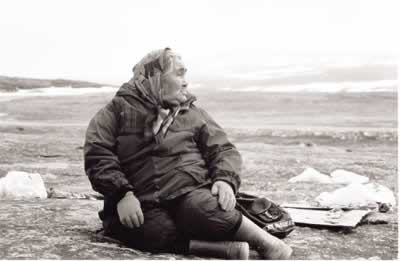 Visions
Inuit is on display from Feb. 16 to 29 in an open-roofed igloo on
the terrace of restaurant-bar Le Pub at Université Laval,
right behind the Pavilion Alphonse-Desjardins.
Visions
Inuit is on display from Feb. 16 to 29 in an open-roofed igloo on
the terrace of restaurant-bar Le Pub at Université Laval,
right behind the Pavilion Alphonse-Desjardins.